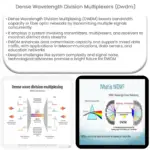Introduction to DWDM
DWDM stands for Dense Wavelength Division Multiplexing. It is a technology that enables the transmission of multiple optical signals over a single optical fiber, each on a different wavelength. This technology has revolutionized the world of telecommunications, allowing for faster and more efficient data transmission.
Before the development of DWDM, traditional fiber optic cables could only transmit one signal at a time. This limitation made it difficult to transmit large amounts of data over long distances. With DWDM, multiple signals can be transmitted simultaneously, allowing for much greater capacity and flexibility.
How DWDM works
DWDM works by using a multiplexer to combine multiple optical signals onto a single fiber. Each signal is assigned a specific wavelength, usually in the range of 1550 nm. The multiplexer then transmits the combined signal over a single fiber. At the other end, a demultiplexer separates the signals back into their original wavelengths, allowing them to be received by their intended recipients.
DWDM uses a technique called wavelength-division multiplexing (WDM) to combine multiple signals onto a single fiber. This technique makes use of the fact that different colors of light (i.e. different wavelengths) can travel through a fiber at the same time without interfering with each other. By assigning each signal a different wavelength, DWDM can transmit multiple signals simultaneously over a single fiber.
Advantages of DWDM
One of the main advantages of DWDM is its ability to greatly increase the capacity of a fiber optic network. With traditional fiber optic cables, the bandwidth is limited by the number of available fibers. With DWDM, multiple signals can be transmitted over a single fiber, greatly increasing the amount of data that can be transmitted.
Another advantage of DWDM is its flexibility. Because it allows multiple signals to be transmitted over a single fiber, it can be used to combine different types of traffic, such as voice and data, onto a single network. This makes it particularly useful for telecommunications companies that need to support a wide range of different services.
Finally, DWDM is a relatively low-cost solution compared to other technologies that achieve similar results. It requires fewer fiber optic cables and is more efficient than traditional methods of transmitting data over long distances.
Example of DWDM application
One common application of DWDM is in long-distance telecommunications networks. DWDM is often used to transmit data between cities or countries, where it is impractical or too expensive to lay multiple fiber optic cables. By using DWDM, telecommunications companies can greatly increase the capacity of their networks and provide more services to their customers.
For example, a telecommunications company might use DWDM to transmit high-speed internet, video, and voice services over a single fiber optic cable between two cities. This would allow the company to provide these services to a large number of customers without having to lay multiple cables. DWDM has played an important role in the growth of the telecommunications industry and will likely continue to be a key technology in the future.




